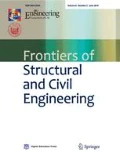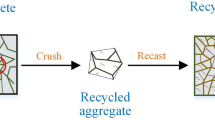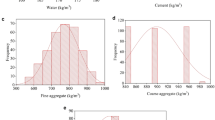Abstract
This study presents a new systematic algorithm to optimize the durability of reinforced recycled aggregate concrete. The proposed algorithm integrates machine learning with a new version of the firefly algorithm called chaotic based firefly algorithm (CFA) to evolve a rational and efficient predictive model. The CFA optimizer is augmented with chaotic maps and Lévy flight to improve the firefly performance in forecasting the chloride penetrability of strengthened recycled aggregate concrete (RAC). A comprehensive and credible database of distinctive chloride migration coefficient results is used to establish the developed algorithm. A dataset composite of nine effective parameters, including concrete components and fundamental characteristics of recycled aggregate (RA), is used as input to predict the migration coefficient of strengthened RAC as output. k-fold cross validation algorithm is utilized to validate the hybrid algorithm. Three numerical benchmark analyses are applied to prove the superiority and applicability of the CFA algorithm in predicting chloride penetrability. Results show that the developed CFA approach significantly outperforms the firefly algorithm on almost tested functions and demonstrates powerful prediction. In addition, the proposed strategy can be an active tool to recognize the contradictions in the experimental results and can be especially beneficial for assessing the chloride resistance of RAC.
Similar content being viewed by others
References
Shaban W M, Elbaz K, Yang J, Thomas B S, Shen X, Li L, Du Y, Xie J, Li L. Effect of pozzolan slurries on recycled aggregate concrete: Mechanical and durability performance. Construction & Building Materials, 2021, 276: 121940
Ouyang K, Shi C, Chu H, Guo H, Song B, Ding Y, Guan X, Zhu J, Zhang H, Wang Y, Zheng J. An overview on the efficiency of different pretreatment techniques for recycled concrete aggregate. Journal of Cleaner Production, 2020, 263: 121264
Guo H, Shi C, Guan X, Zhu J, Ding Y, Ling T C, Zhang H, Wang Y. Durability of recycled aggregate concrete—A review. Cement and Concrete Composites, 2018, 89: 251–259
Shaban W M, Yang J, Su H, Mo K H, Li L, Xie J. Quality improvement techniques for recycled concrete aggregate: A review. Journal of Advanced Concrete Technology, 2019, 17(4): 151–167
Shaban W M, Yang J, Su H, Liu Q F, Tsang D C W, Wang L, Xie J, Li L. Properties of recycled concrete aggregates strengthened by different types of pozzolan slurry. Construction & Building Materials, 2019, 216: 632–647
Kisku N, Joshi H, Ansari M, Panda S K, Nayak S, Dutta S C. A critical review and assessment for usage of recycled aggregate as sustainable construction material. Construction & Building Materials, 2017, 131: 721–740
Vázquez E, Barra M, Aponte D, Jiménez C, Valls S. Improvement of the durability of concrete with recycled aggregates in chloride exposed environment. Construction & Building Materials, 2014, 67: 61–67
Xuan D X, Zhan B J, Poon C S. Durability of recycled aggregate concrete prepared with carbonated recycled concrete aggregates. Cement and Concrete Composites, 2013, 35: 32–38
Kwon S J, Kim S C. Concrete mix design for service life of RC structures exposed to chloride attack. Computers and Concrete, 2012, 10(6): 587–607
Zhuang X, Guo H, Alajlan N, Zhu H, Rabczuk T. Deep autoencoder based energy method for the bending, vibration, and buckling analysis of Kirchhoff plates with transfer learning. European Journal of Mechanics. A-Solids, 2021, 87: 104225
Samaniego E, Anitescu C, Goswami S, Nguyen-Thanh V M, Guo H, Hamdia K, Zhuang X, Rabczuk T. An energy approach to the solution of partial differential equations in computational mechanics via machine learning: Concepts, implementation and applications. Computer Methods in Applied Mechanics and Engineering, 2020, 362: 112790
Shaban W M, Yang J, Elbaz K, Xie J, Li L. Fuzzy-metaheuristic ensembles for predicting the compressive strength of brick aggregate concrete. Resources, Conservation and Recycling, 2021, 169: 105443
Shaban W M, Elbaz K, Yang J, Shen S L. A multi-objective optimization algorithm for forecasting the compressive strength of RAC with pozzolanic materials. Journal of Cleaner Production, 2021, 327: 129355
Anitescu C, Atroshchenko E, Alajlan N, Rabczuk T. Artificial neural network methods for the solution of second order boundary value problems. Computers, Materials & Continua, 2019, 59(1): 345–359
Guo H, Zhuang X, Rabczuk T. A deep collocation method for the bending analysis of kirchhoff plate. Computers, Materials & Continua, 2019, 59(2): 433–456
Garson GD. Interpreting neural-network connection weights. AI Expert, 1991, 6(4): 47–51
Swingler K. Applying Neural Networks: A Practical Guide. New York, NY: Academic, 1996: 442
Derrac J, García S, Molina D, Herrera F. A practical tutorial on the use of nonparametric statistical tests as a methodology for comparing evolutionary and swarm intelligence algorithms. Swarm and Evolutionary Computation, 2011, 1(1): 3–18
Elbaz K, Shen S L, Zhou A N, Yuan D J, Xu Y S. Optimization of EPB shield performance with adaptive neuro-fuzzy inference system and genetic algorithm. Applied Sciences-Basel, 2019, 9(4): 780
Kohavi R. A Study of Cross-Validation and Bootstrap for Accuracy Estimation and Model Selection. In: International joint conference on Artificial intelligence. 1995, 1137–1143
May R M. Simple mathematical models with very complicated dynamics. Nature, 1976, 261(5560): 459–467
Elbaz K, Shen S L, Zhou A, Yin Z Y, Lyu H M. Prediction of disc cutter life during shield tunneling with AI via incorporation of genetic algorithm into GMDH-type neural network. Engineering, 2021, 7(2): 238–251
Friedman M. The use of ranks to avoid the assumption of normality implicit in the analysis of variance. Journal of the American Statistical Association, 1937, 32(200): 675–701
Elbaz K, Shen S L, Sun W J, Yin Z Y, Zhou A N. Prediction model of shield performance during tunneling via incorporating improved particle swarm optimization into ANFIS. IEEE Access, 2020, 8: 39659–39671
Miskony B, Wang D. Construction of prediction intervals using adaptive neurofuzzy inference systems. Applied Soft Computing, 2018, 72: 579–586
Bui D K, Nguyen T, Chou J S, Nguyen-Xuan H, Ngo T D. A modified firefly algorithm-artificial neural network expert system for predicting compressive and tensile strength of highperformance concrete. Construction & Building Materials, 2018, 180: 320–333
Thomas K, Michal P, Adam V, Roman S. Firefly algorithm enhanced by orthogonal learning. In: 7th Computer Science On-Line Conference (CSOC), Artificial intelligence and algorithms in intelligent systems. Cham: Springer International Publishing, 2019, 477–488
Wang H, Wang W, Zhou X, Sun H, Zhao J, Yu X. Firefly algorithm with neighborhood attraction. Information Sciences, 2017, 383: 374–387
Wang C F, Song W X. A novel firefly algorithm based on gender difference and its convergence. Applied Soft Computing, 2019, 80: 107–124
Li G, Liu P, Le C, Zhou B. A novel hybrid meta-heuristic algorithm based on the cross-entropy method and firefly algorithm for global optimization. Entropy (Basel, Switzerland), 2019, 21(5): 494
Wang W, Xu L, Chau K, Xu D. Yin-Yang firefly algorithm based on dimensionally Cauchy mutation. Expert Systems with Applications, 2020, 150: 113216
Zhang H, Zhao Y, Meng T, Shah S P. Surface treatment on recycled coarse aggregates with nanomaterials. Journal of Materials in Civil Engineering, 2016, 28(2): 04015094
Yang J, Shaban W M, Elbaz K, Thomas B S, Xie J, Li L. Properties of concrete containing strengthened crushed brick aggregate by pozzolan slurry. Construction & Building Materials, 2020, 247: 118612
Kou S C, Poon C S. Long-term mechanical and durability properties of recycled aggregate concrete prepared with the incorporation of fly ash. Cement and Concrete Composites, 2013, 37: 12–19
Lotfy A, Al-Fayez M. Performance evaluation of structural concrete using controlled quality coarse and fine recycled concrete aggregate. Cement and Concrete Composites, 2015, 61: 36–43
Somna R, Jaturapitakkul C, Chalee W, Rattanachu P. Effect of the water to binder ratio and ground fly ash on properties of recycled aggregate concrete. Journal of Materials in Civil Engineering, 2012, 24(1): 16–22
Mousa M I, Mahdy M G, Abdel-Reheem A H, Yehia A Z. Self-curing concrete types: water retention and durability. Alexandria Engineering Journal, 2015, 54(3): 565–575
Kou S C, Poon C S, Chan D. Influence of fly ash as a cement addition on the hardened properties of recycled aggregate concrete. Materials and Structures, 2008, 41(7): 1191–1201
Bui N K, Satomi T, Takahashi H. Mechanical properties of concrete containing 100% treated coarse recycled concrete aggregate. Construction & Building Materials, 2018, 163: 496–507
Vakhshouri B, Nejadi S. Prediction of compressive strength of self-compacting concrete by ANFIS models. Neurocomputing, 2018, 280: 13–22
Jang J S. ANFIS: Adaptive-network-based fuzzy inference system. IEEE Transactions on Systems, 1993, 23(3): 665–685
Jang J S R, Sun C T, Mizutani E. Neuro-fuzzy and soft computing-A computational approach to learning and machine intelligence. IEEE Transactions on Automatic Control, 1997, 42(10): 1482–1484
Taherdangkoo M, Bagheri M H. A powerful hybrid clustering method based on modified stem cells and Fuzzy C-means algorithms. Engineering Applications of Artificial Intelligence, 2013, 26(5–6): 1493–1502
Yang X S. Firefly algorithm, stochastic test functions and design optimization. International Journal of Bio-inspired Computation, 2010, 2(2): 78–84
Wang H, Wang W, Sun H, Rahnamayan S. Firefly algorithm with random attraction. International Journal of Bio-inspired Computation, 2016, 8(1): 33–51
Yu S, Su S, Lu Q, Huang L. A novel wise step strategy for firefly algorithm. International Journal of Computer Mathematics, 2014, 91(12): 2507–2513
Coelho L D S, Mariani V C. Use of chaotic sequences in a biologically inspired algorithm for engineering design optimization. Expert Systems with Applications, 2008, 34(3): 1905–1913
Gandomi A H, Yang X S, Talatahari S, Alavi A H. Firefly algorithm with chaos. Communications in Nonlinear Science and Numerical Simulation, 2013, 18(1): 89–98
Zhou W H, Garg A, Garg A. Study of the volumetric water content based on density, suction and initial water content. Measurement, 2016, 94: 531–537
Jiang P, Chen J. Displacement prediction of landslide based on generalized regression neural networks with K-fold cross-validation. Neurocomputing, 2016, 198: 40–47
Bravo M, de Brito J, Pontes J, Evangelista L. Durability performance of concrete with recycled aggregates from construction and demolition waste plants. Construction & Building Materials, 2015, 77: 357–369
Kou S C, Poon C S. Effect of the quality of parent concrete on the properties of high performance recycled aggregate concrete. Construction & Building Materials, 2015, 77: 501–508
Ann K Y, Moon H Y, Kim Y B, Ryou J. Durability of recycled aggregate concrete using pozzolanic materials. Waste Management, 2008, 28(6): 993–999
Kong D, Lei T, Zheng J, Ma C, Jiang J, Jiang J. Effect and mechanism of surface-coating pozzolanic materials around aggregate on properties and ITZ microstructure of recycled aggregate concrete. Construction & Building Materials, 2010, 24(5): 701–708
Kou S C, Poon C S, Chan D. Influence of fly ash as cement replacement on the properties of recycled aggregate concrete. Journal of Materials in Civil Engineering, 2007, 19(9): 709–717
Kou S C, Poon C S, Agrela F. Comparisons of natural and recycled aggregate concretes prepared with the addition of different mineral admixtures. Cement and Concrete Composites, 2011, 33(8): 788–795
Kou S C, Poon C S. Enhancing the durability properties of concrete prepared with coarse recycled aggregate. Construction & Building Materials, 2012, 35: 69–76
Acknowledgments
The research work was funded by “The Pearl River Talent Recruitment project” in 2019 (No. 2019CX01G338), Guangdong Province & Shantou University Research Funding for New Faculty Member (No. NTF19024-2019).
Author information
Authors and Affiliations
Corresponding author
Rights and permissions
About this article
Cite this article
Shaban, W.M., Elbaz, K., Amin, M. et al. A new systematic firefly algorithm for forecasting the durability of reinforced recycled aggregate concrete. Front. Struct. Civ. Eng. 16, 329–346 (2022). https://doi.org/10.1007/s11709-022-0801-9
Received:
Accepted:
Published:
Issue Date:
DOI: https://doi.org/10.1007/s11709-022-0801-9




